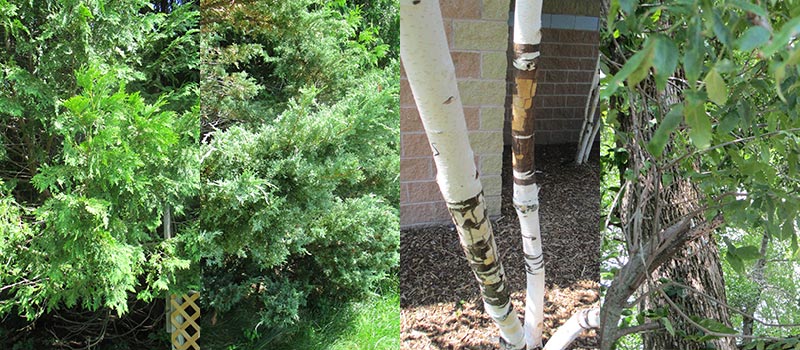
image #1: A White Ash at Camp Agudah. Note the drooping samoras (winged fruits), known as “keys.”
image #2: An Eastern Red Cedar on camp grounds.
image #3: A Paper Birch outside Camp Agudah’s main building.
image #4: A Northern White Cedar in the same area.
Like everyone else, I am aware of the speed with which summer is speeding by us. And especially now that Tisha B’Av has passed and we have finally arrived at Tu B’Av, which tells us that the power of the sun has already begun to wane, we realize that autumn days are just around the corner. Here in the Catskill, where I customarily spend my summers as Director of Special Activities at Camp Agudah, some of the trees already have assumed a distinctly reddish hue—in particular, the Mountain Maples and the Staghorn Sumacs. In Marine Park, on the other hand, you will still generally have a nice chunk of time left until you become aware of major changes in leaf coloration.
Indeed, the trees of summer help make the outdoor experience more than enjoyable: they are the stuff of memories. The White Ash trees, the Birches, and the so-called “Cedars” (Eastern Red Cedar and Northern White Cedar: the first is really a juniper; the second, an arborvitae) lend their uniqueness to the summertime ambiance—and I for one am so grateful. I might even be moved to declare that Ash, Birch, and Cedar comprise the A BC’s of the Catskill tree world!
Let’s begin with White Ash, the tallest of the Ashes (other Ash trees come with various specific color descriptors: Blue Ash, Black Ash, and Green Ash). While the White Ash is a graceful-looking tree, what might interest the casual observer is that the wood of this species (its botanical name is Fraxinus americana; interestingly enough, Ash trees are part of the same family as Olive trees) was the material of choice for crafting Louisville Slugger and other non-metallic baseball bats. Native Americans also appreciated this hardwood and used it to make their bows. As for me, during the summer I have raptly watched the one-winged seeds of the White Ash tree samaras, known as “keys,” drooping in clusters from the branches and then gently gliding to the ground to give rise possibly to a new generation of Ash trees.
If A stands for Ash, then B must represent Birch. Here at Ferndale, NY’s Camp Agudah we have a number of different Birch trees: Paper Birch, Yellow Birch, and Black (also known as Sweet Birch or Cherry Birch: the bark of Black Birch and Cherry trees is quite similar). Yellow and Black Birch exude the distinctive odor of wintergreen. I have often demonstrated that one can even chew the tiny twigs of the Black Birch and actually enjoy the taste of the wood; no wonder that for decades Black Birch has been the major flavoring ingredient of birch beer!
Paper Birch (Betula papyrifera) served the American Indians well: they made canoes from it (and so it is sometimes called “Canoe Birch”). We have some beautiful Paper Birches lighting up, as it were, the foreground of our main building here in camp. The peeling bark practically invites you to take a piece and write a note upon it!
Finally, we have designated the letter C to represent two widely spread trees: the Eastern Red Cedar and the Northern White Cedar—but guess what! In truth, neither one is a true cedar. The first is actually a Juniper (Juniperus virginiana); the second, an Arborvitae (Thuja occidentalis). But oh, do they smell good! I grew up to admire the sight of Eastern Red Cedars in Connecticut, but the smell of their ruddy wood is what remains with me to this very day. (My readers might remember Eastern Red Cedar wood as being the main component of kitty litter—or as the raw material from which “cedar” closets and the finer sort of pencils have been fashioned.) And the Northern White Cedar is even more aromatic; moreover, its “flattened sprays” (the words of one botanical scholar) make wonderful schach for our sukkahs.
Why, it’s as simple as ABC! Ash, Birch, and “Cedar” are quite obviously part of the Divine plan to make our summers memorable—and not just a time to loll around. In fact, these dignified representatives of the plant kingdom contribute to making the summer a “tree-mendous” (sorry about that!) experience. And once again they remind us that the so-called Great Outdoors may provide summer lessons far and away more impressive than we could have ever imagined. Nature is in so many ways a kind of Divinely appointed teacher.
Are you at all surprised? For, in the final analysis, the word “hateva” (nature) has the same gematriya (86) as E-LOKIM!
__________
Questions or comments? These may be sent to me at hillyarm@yeshivanet.com. Enjoy the remainder of this beautiful summer season, dear readers!
You must be logged in to post a comment.